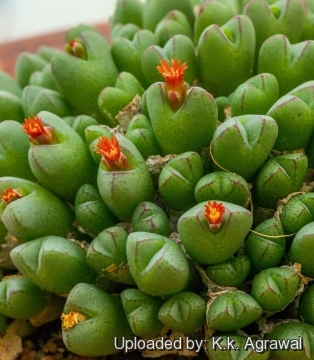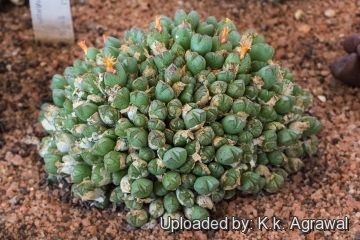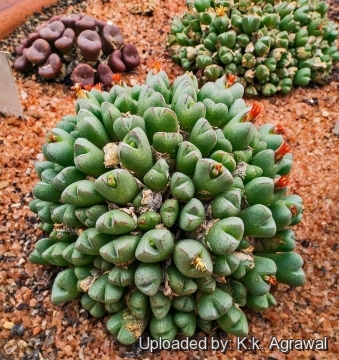Accepted Scientific Name: Conophytum loeschianum Tischer
Sukkulenta 225 1931

Conophytum saxetanum var. loeschianum (Conophytum loeschianum) Photo by: K.k. Agrawal
Almost in full bloom!!!
Origin and Habitat: Namibia (Lüderitz-South), South-Africa (Northern Namaqualand, Northern Cape) on quartz or Altitude range: 450-1200 metres over sea level.
Habitat and ecology: Conophytum loeschianumSN|22696]]SN|22696]] tolerates highly arid situations and grows within incredible small cracks in hard-granite slopes, often half-shaded together with Sarcocaulon multifidumSN|32359]]SN|32359]], Tylecodon hallii and Tylecodon buchholzianus.
Synonyms:
See all synonyms of Conophytum loeschianum
Common Names include:
CHINESE (中文): 小猪蹄
Description: Conophytum loeschianumSN|22620]]SN|22696]] is a densely caespitose succulent plans, forming small or large, very compact mats or domes. The bodies (modified leaves) are very small only few millimetres in size Flowers are nocturnal and always have some sort of coppery-orange colouration.
Bodies: Less than 12 mm long, 2-6 mm thick, strongly keeled, pale green to yellowish-green, glabrous, very smooth, keels usually red-lined.
Flowers: Tiny, nocturnal, narrow, typical of the Saxetana section. Petals coppery-orange to reddish or (rarely) white.
Fruits: 5-6-chambered.
Similar species: This plant is sometimes confused with another small species: Conophytum saxetanumSN|22686]]SN|22686]], but C. loeschianum has always sharper, often bright red keels. It also replaces Conophytum hiansSN|22696]]SN|22620]] in the more northerly part of the Richtersveld around the Orange River. Compared to that species, it can be recognised by the orange flowers and the frequent red keel line; it also tends to have smoother bodies.
Bibliography: Major references and further lectures
1) Heidrun E.K. Hartmann “Illustrated Handbook of Succulent Plants: Aizoaceae F-Z” Springer Science & Business Media, 2002
2) Gideon Smith u.a. “Mesembs of the World: Illustrated Guide to a Remarkable Succulent Group.” Briza Publications, 1998
2) Gideon Smith u.a. (Hrsg.) "Mesembs of the World: Illustrated Guide to a Remarkable Succulent Group." Briza Publications, 1998
3) Hermann Jacobsen “A handbook of succulent plants: descriptions, synonyms, and cultural details for succulents other than Cactaceae, Volume 1” Blandford Press, 1960
4) Werner Rauh “The Wonderful World of Succulents:Cultivation and Description of Selected Succulent Plants Other Than Cacti” Smithsonian Institution Press, 1984
7) James Cullen, Sabina G. Knees, H. Suzanne Cubey “The European Garden Flora Flowering Plants: A Manual for the Identification of Plants Cultivated in Europe, Both Out-of-Doors and Under Glass” Cambridge University Press, 11/ago/2011
8) Victor, J.E. 2006. Conophytum loeschianum Tischer. National Assessment: “Red List of South African Plants” version 2014.1. Accessed on 2014/07/11
9) Steven A. Hammer “Dumpling and his wife: new views of the genus Conophytum” EAE Creative Colour Ltd., 2002
 A night flowering species with orange-coppery color flowers (Conophytum loeschianum) Photo by: K.k. Agrawal
A night flowering species with orange-coppery color flowers (Conophytum loeschianum) Photo by: K.k. Agrawal Note the remains of the dry cuticle that covers and protects the vital parts of the plant during the dry season. (Conophytum loeschianum) Photo by: K.k. Agrawal
Note the remains of the dry cuticle that covers and protects the vital parts of the plant during the dry season. (Conophytum loeschianum) Photo by: K.k. Agrawal Conophytum saxetanum var. loeschianum (Conophytum loeschianum) Photo by: K.k. Agrawal
Conophytum saxetanum var. loeschianum (Conophytum loeschianum) Photo by: K.k. AgrawalSend a photo of this plant.The gallery now contains thousands of pictures, however it is possible to do even more. We are, of course, seeking photos of species not yet shown in the gallery but not only that, we are also looking for better pictures than those already present.
Read More... Cultivation and Propagation: Conophytum loeschianumSN|22696]]SN|22696]] is a "winter" grower which is most active from late winter until later spring and heading for summer dormancy.
Soil: Best in pots. Requires good drainage as it it is prone to root rot. It can grows outdoor in sunny, dry, rock crevices (protection against winter wet is required) It can also be cultivated in alpine house, in poor, drained soil.
Watering: It requires little water; otherwise its epidermis breaks (resulting in unsightly scars). Water minimally in summer, (only when the plant starts shrivelling), but it will generally grow even in summer if given water. Water regularly in winter after the previous year's leaves have dried up. Requires good drainage.
Fertilization: Feed it once during the growing season with a fertilizer specifically formulated for cactus succulents (poor in nitrogen), including all micro nutrients and trace elements diluted to ½ the strength recommended on the label. It thrives in poor soils and need a limited supplies of fertilizer to avoid the plants developing excess vegetation, which is easily attacked by fungal diseases.
Exposure: Keep cool and shaded in summer, it needs full sun or light shade.
Temperature: Hardy to -2°C. Ensure a very good ventilation.
Repotting: Avoid to repot frequently. This plant may stay in the same pot for many years.
Uses: Container, rock garden.
Pests and diseases: It is vulnerable to mealybugs and rarely scale.
Propagation: It can be reproduced both by cuttings and seeds. Take the cutting from a grown-up mother plant. Each cutting must contain one or more heads along with a fraction of root. It is easily propagated by seed. The small seeds can be sown in pots of fine, well-drained sand, any time during the spring and summer months when temperatures are warm. Cover the seeds with a very fine layer of grit and water from below with a fungicide to prevent damping off. For the first 3-4 days cover the pots with a sheet of glass/clear perspex to keep the humidity levels high. Remove the glass and replace it with light shadecloth and mist once or twice a day for the next two weeks after which most seeds should have germinated. From then on mistings can be reduced to every second and then every third day as the little plants grow.













